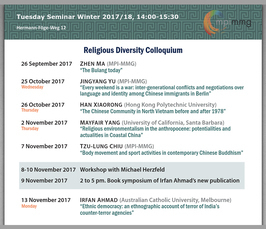"Religious environmentalism in the anthropocene: potentialities and actualities in Coastal China"
Religious Diversity Colloquium Winter 2017/18
- Date: Nov 2, 2017
- Time: 02:00 PM - 03:30 PM (Local Time Germany)
- Speaker: Mayfair Yang (University of California, Santa Barbara)
- Mayfair Yang received her Ph.D. in Anthropology from UC Berkeley. She has been a faculty member in the Anthropology Department at UC Santa Barbara, and in Religious Studies Department and East Asian Studies Department at the same university. She was Director of Asian Studies at the University of Sydney in Australia, and has held visiting scholar or fellowship positions at University of Michigan, University of Chicago, Harvard University, Academia Sinica in Taiwan, Beijing and Fudan Universities in China, and the Institute for Advanced Study in Princeton. She is the author of Gifts, Favors, & Banquets: the Art of Social Relationships in China, and editor of Chinese Religiosities: Afflictions of Modernities & State Formation and Places of Their Own: Women’s Public Sphere in Transnational China. Her forthcoming book is: Re-enchanting Modernity: Ritual Economy & Indigenous Civil Society in Wenzhou, China (Duke University Press). She is also working on a second, more theoretical book on Wenzhou religiosity.
- Location: MPI-MMG, Hermann-Föge-Weg 12, Göttingen
- Room: Conference Room

For more details please contact vdvoffice(at)mmg.mpg.de.
This paper argues that in the age of the Anthropocene, when secular and scientific discourses of environmentalism have not made significant impact, and have even generated denials, we must explore how religiosity and environmentalism can merge and join paths. In this endeavour, we cannot restrict ourselves to studies of religious texts and scriptures, the dominant approach today. For religious traditions are not mere texts, but historical interpretations of texts, and texts cannot stand in for religious practices, which draw upon non-literate and embodied traditions. How is it that a “resistant text” such as the Bible, was able to generate environmental action, but the many environmentally-friendly Asian religious traditions have yet to live up to their rich ecological promise? Our exploration calls for the ethnographic method, in search of how ordinary people have understood religious teachings and merged religious with environmental feelings and actions. I present four ethnographic examples from Wenzhou, China, and discuss the potentialities and actualities of religious contributions to a Green Movement in China.